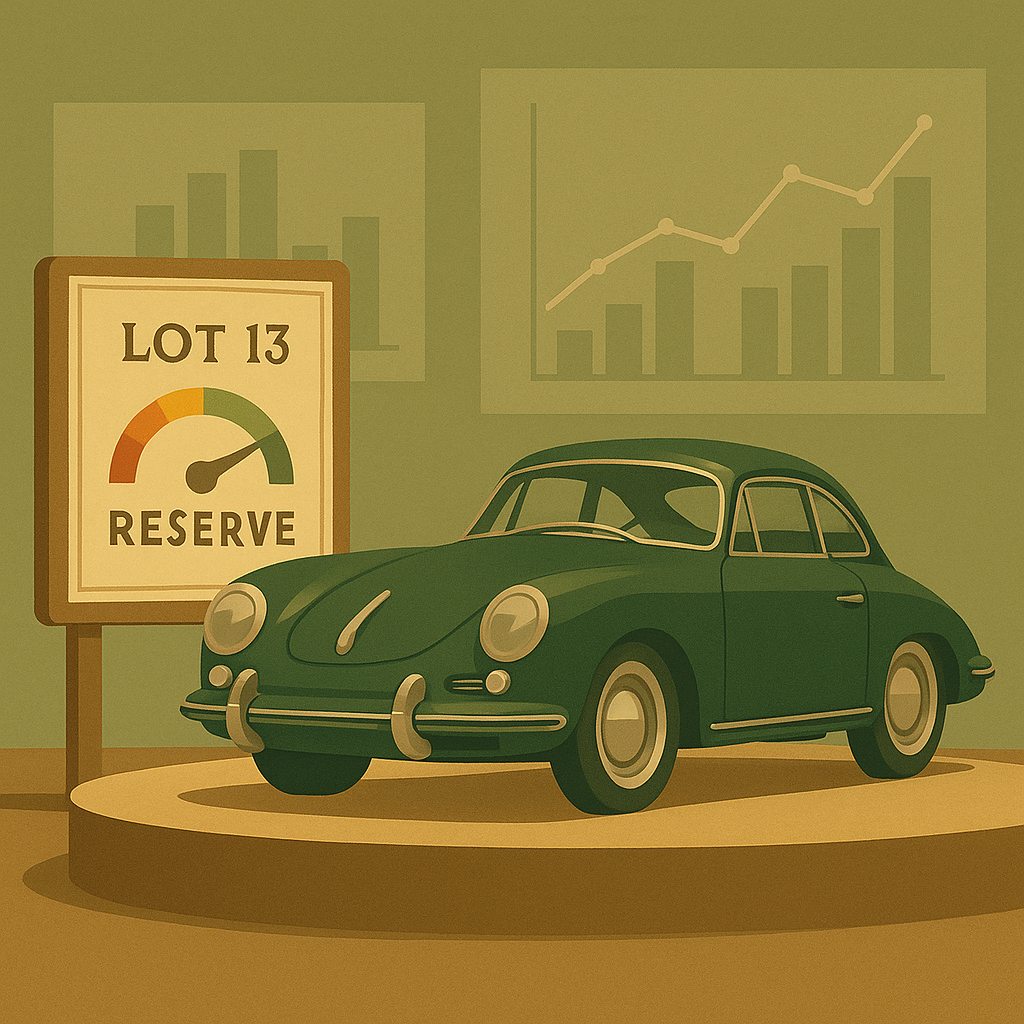Reserve Smarter: Setting Floors That Attract Bids

Reserve Smarter: Setting Floors That Attract Bids
Seller-side, data-first reserve strategy for online vehicle auctions.
If you’ve ever listed a car online, you know the reserve is both a seatbelt and a speed limiter. Set it too low and you risk leaving money on the table. Set it too high and you get “reserve not met,” cold momentum, and fewer bidders the next time around. The smartest sellers treat reserves like an instrument panel: read the gauges, tune for conditions, and keep the engine in its power band.
This guide shows how to set a reserve that protects your floor while inviting real bidding—using clear math, timing, and presentation signals. Think of it as quiet discipline that compels action from potential bidders.
THE PROBLEM: AMBITIOUS RESERVES KILL MOMENTUM
Reserves serve as messages to bidders. When a reserve feels unreachable to potential buyers, engagement falls off a cliff: fewer watchers, fewer bids, and a comment section that never warms up. That lull also poisons the algorithmic wells in online auctions (email placements, “ending soon” carousels, social chatter) that actually deliver bidders to your vehicle A high reserve can cost you twice: once when the car fails to sell, and again when the re-list has to overcome a “passed last time” stigma.
A smart reserve does the opposite. It acts as a confidence anchor: bidders feel the car is attainable, they engage early, and that engagement becomes social proof that pulls in more bidders. Momentum compels the room; the room compels the price.
THE IDEA: A FLOOR THAT INVITES BIDS
Build your reserve from the ground up, then stress-test it against how auctions actually move. Here is the formula you can use:
Reserve = Adjusted FMV − (fees + prep + time cost) − momentum penalty
FMV baseline: BidBud can provide you with recent comps that match spec, mileage band, condition, provenance, and timeframe. You should weigh the most similar two or three sales.
Car-specific adjustments: condition deltas (PPI notes, paint meter, underbody), spec premiums/penalties (transmission, color, options, originality), documentation strength (records, provenance).
Transaction friction: seller/platform fees, transport and prep, expected closing costs (if any), and the time cost of holding the vehicle for another 30–45 days.
Momentum penalty: a small buffer (typically 1.5–3.5% on mainstream enthusiast cars; higher for thin markets) to protect against low-engagement auctions.
If the final number feels tight, you’re learning something valuable: you maybe out of season, on the wrong platform, or asking the market to pay for sunk costs. Fix the cause rather than inflating the reserve. Remember, you can always purchase a BidBud Insights Report to get a custom analysis on your vehicle and recommendations for your listing!
THE AUCTION DYNAMICS THAT MATTER
Price momentum is attention momentum. Close-times, audience depth, and presentation quality are the silent metrics on your reserve risk.
Close-time windows: target weeknights in your target time zone or late weekend morning/early afternoon when phones are in hand. Avoid big event conflicts (F1, Monterey/Pebble, Barrett-Jackson) that siphon attention!
Platform audience: match segment to venue. For example, you don't want to sell a modified Scion FR-S on Bring a Trailer, but you may want to sell it on Cars and Bids.
Presentation quality: pro photos, underbody shots, walk-around video, and records packaged as a single-labeled PDF. Trust is the best way to sell your car. Remember: people are buying the car and seller!
WHERE BIDBUD FITS IN
BidBud Insights can help you set confident, engagement-friendly reserves by analyzing:
• Recent comparable sales (spec, mileage, condition, originality, options, hammer price).
• Market momentum (week-to-week movement for similar vehicles and trims).
• Close-time effects (day-of-week and hour-of-day metrics about attention).
• Bid velocity patterns (when activity typically stalls or spikes in your segment).
• Presentation quality signals (photo coverage, document depth, comment credibility).
The goal is to empower sellers with context. Instead of guessing, you see practical guidance:
• A reserve band grounded in recent comps and friction.
• A suggested momentum penalty based on your segment’s volatility.
• Recommended close windows where engagement is historically strongest.
• A short “trust checklist” tuned to your car to reduce bidder hesitation.
THE LONG ROAD AHEAD
BidBud is early.
The future of online auctions is reserve intelligence baked into the platforms themselves—real-time market analysis, engagement-aware reserve bands, and seller dashboards that illuminate why a car performed the way it did. BidBud’s aim is simple: transparency that protects sellers, respects buyers, and keeps auctions as smart as the machines we love.
Long-term, BidBud plans on integrating with online auctions themselves, in order to make the end-to-end auction process as seamless as possible for everyone involved.




